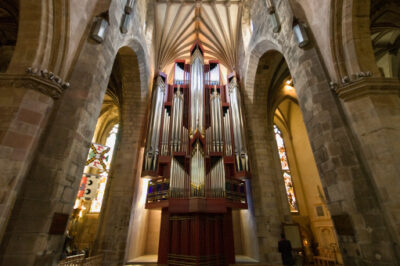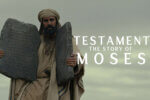Many believers ‘tame’ the gospel story by making it pragmatic, logical and relevant. But like a Gothic cathedral, the Good News has to be experienced in person to discover its true breathtaking wonder.
The Gospel of Mark was the first of the four Gospels to be written, and its original ending seemed strange and abrupt. At a later date, a longer and more satisfying ending was appended; but Mark’s original conclusion to his Gospel narrative was simply this: “And they went out and fled from the tomb, for trembling and astonishment had seized them, and they said nothing to anyone, for they were afraid” (16:8, ESV). The End.
But how can that be the end? It’s so sudden, so abrupt, so lacking in resolution or explanation. We’re left with three women fleeing from the empty tomb, trembling, astonished and speechless. It’s as if the film in the projector simply ran out and we find ourselves sitting in the theater, puzzled by the unexpected ending.
Yet this was the original ending to Mark’s Gospel. Fear, trembling and astonished silence. Of course we understand why eventually the need was felt to add a more thorough ending (17 additional verses), as the other Gospels have. There needed to be a further explanation of the empty tomb.
Christian theology in its essence is the extrapolation of implications based on the resurrection of Jesus Christ. The book of John, the last Gospel written, has two full chapters after the Resurrection account. There is much to be written about, thought out, worked out; in fact, this is what the New Testament epistles are—the outworking of Resurrection implications.
But! … Mark’s original ending was the perfect way to end the first Gospel, if only for a while. Astonishment accompanied by fear and trembling, evoking stunned silence should be our first response to the gospel! Just think how unsatisfactory it would have been if Mary Magdalene had calmly said, “Oh, yes, this makes perfect sense”—and then gone on to give the other two women some erudite explanation like a German theologian giving a university lecture. If explanation had been the first response to the Resurrection, something would have been wrong.
And something is wrong!
What’s wrong is that we have precious little astonishment in our modern gospel. We’re familiar with it. It’s in danger of degenerating into cliche. It has only the faux astonishment of a late-night infomercial. For only $19.95! But wait, there’s more! Call now! We yawn and change the channel. I’m afraid that’s how our gospel is too often heard.
But consider how the gospel sounded upon its first hearing in the first century: A Galilean Jew named Jesus was executed by crucifixion by the Roman government for alleged crimes against the state; three days later God raised Him from the dead; He is now the world’s new emperor.
That’s the gospel! It’s not an explanation; it’s an announcement. It may sound absurd, but it’s certainly not cliché. No matter what else one might say about this gospel, it is certainly an astonishing claim.
But in our modern sophistication we have replaced astonishment with something a bit tamer. We have made the gospel reasonable, sensible and practical. We explain the gospel in cogent terms such as “the plan of salvation” and “spiritual laws”—as if it is simply the most rational thing in the world.
The gospel is now commonsense, logical and, most of all, “useful.” We have no use for astonishment because, well, we have no use for astonishment. Astonishment is not something we can use—it’s not something pragmatic we can make use of to further our self-concocted and self-oriented agendas. So instead of announcing an astonishing gospel, we find ourselves trying to sell a useful gospel. Evangelism takes on the tone of a multilevel marketing presentation. Some buy it, some don’t; but not many are astonished.
Yet astonishment is the most appropriate initial reaction to the gospel story (and it is a story, not a set of propositions). What if the three women at the tomb on the first Easter had calmly responded to the angel with a series of consumerist questions like this: “What do I do with this?” “How do I use it?” “How can I make this practical in my life?”—as if the angel had just presented them a business plan.
No! The gospel properly proclaimed and properly heard is a mystery evoking awe; it’s not a prospectus-eliciting calculation. Without astonishment as our initial response, we meet Christianity in a wrong way—or more properly, we meet Christ in a wrong way.
Without astonishment we inevitably reduce the gospel to inert “-ology” and “-ism.” Or worse, it becomes a spiritual “product” that we must “market.” This is consumer Christianity, and it is the bane of our age. Perhaps we actually believe the gospel is a kind of product. God help us! We need to once again be astonished like the three women on that first Easter—not by what the gospel can do, but first of all for what it is!
Throughout the second half of the 20th century, and now into the 21st century, American evangelicals have increasingly touted the virtues of the gospel by promoting it as “practical.” This has become something of an article of faith. It is unquestioned and fully assumed that we should make the gospel practical.
The goal of every sermon is to give a practical way of applying it to your life. We even speak of making the Bible “relevant.” (How grateful God must be that someone has at last made his Word relevant!)
But do we fail to see that this is the secular language of the market and not the sacred language of mystery? This is the language of consumerism, not the language of Christianity. This is the language of business, not the language of faith.
Of course the argument is: How are we going to get any takers if we don’t sell the gospel on practical grounds? How indeed?
Perhaps we will have to place some faith in the gospel and in Jesus Christ Himself. Perhaps we will have to believe that the gospel story itself, faithfully told, still has the capacity to astonish. Perhaps we will have to believe that the risen Christ can still make Himself known in astonishing ways.
Some years ago a girl from our church was on a missions trip to Spain where she had an opportunity to visit the great Cathedral of Barcelona, La Seu. It is a triumph of medieval Gothic architecture that still inspires worshippers and visitors today.
Gothic architecture, with its soaring arches, flying buttresses, ribbed vaults and enormous stained-glass windows, was designed to evoke an awareness of the transcendent and an overwhelming sense of awe in the worshipper. It was an architectural attempt to connect heaven and earth.
After the completion of La Seu 5.5 centuries earlier, a young American girl from an evangelical background had her first encounter with a great European Gothic cathedral. She described it to me like this:
“The ornate arcs caused my eyes to lift up, as if into heaven. The soft afternoon sunlight poured in through the stained glass. Dust particles floated timelessly through the hazy light. The depiction of Christ crucified came into focus.
“I felt as though my soul had transcended the earth. I wanted nothing more than to fall on my knees and worship in this ancient, beautiful and holy place. Hot tears fell down my face.”
This American teenager was so overwhelmed by an encounter with sacred beauty that she was moved to tears. Why? She was astonished. Having grown up in the soulless strip-mall, plastic culture of American suburbia and its ubiquitous pragmatism, she suddenly had a devastating encounter with what we have lost—holy mystery and sacred beauty.
In the Barcelona cathedral, this young evangelical recognized—perhaps as a metaphor—that we have lost something we cannot really live without. We’ve lost mystery and beauty and the power they have to produce the kind of astonishment that naturally leads to worship.
My point is not the obvious fact that a Gothic cathedral has a different effect upon our souls than a sterile big-box store. I’m not really talking about architecture; I’m using it as a metaphor. What we need is the kind of Christianity that can produce in people the kind of astonishment that the cathedral produced in the American teenager.
What we need in our faith, theology and witness is to build a cathedral of astonishment. Or more accurately, we need to rediscover and preserve the cathedral of astonishment that is authentic Christianity when it’s imbued with mystery and beauty.
Consider: We confess a Trinity, one God who is Father, Son and Holy Spirit. We believe in the mystery of the Incarnation—that the Word became flesh through a virgin birth. We proclaim that somehow God saves the world through the execution of a particular Jew outside the city of Jerusalem in the early first century. We preach that this crucified man—Jesus of Nazareth—has been raised from the dead.
Furthermore, we confess He ascended to the right hand of the Father and now rules the nations as King of kings and Lord of lords. We believe He is coming again to judge the living and the dead. We believe that through Him will come the resurrection of the dead and all things made new.
Every bit of this is astonishing! These are our soaring arches, flying buttresses, ribbed vaults and stained-glass windows. They are not practical; they are mysterious and beautiful!
Nothing about the essential creeds and central confessions of orthodox Christianity readily lend themselves to pragmatic self-improvement programs. Asking, “How do I apply the Trinity to my life so as to make it practical?” is asking the wrong kind of question. It would be like asking the custodians of the Barcelona cathedral, “How do I apply this to my life?” They wouldn’t even understand the question.
Christianity is not something you “add to your life.” It is something you enter. (It is a cathedral!) And you enter on its terms, not yours. Christ is the door that leads to this astonishing cathedral called salvation. To enter into authentic Christianity is to leave the shrunken world of staid moralism and sterile pragmatism. It is to enter a kind of cathedral that is so big, so beautiful, so astonishing that worship is the only acceptable response.
What I’m trying to say is that Christianity with its sacred mysteries is a grand and gorgeous cathedral. It is something much bigger and more beautiful than what we have become accustomed to in a stripped-down pragmatized Christianity sold on the cheap at the local God-Mart.
As Christians we are the heirs of a faith that has been entrusted to us—the faith that was “once for all” entrusted to the saints (Jude 1:3). We are not the architects of the faith; we are the trustees. And we have been reckless with the received faith. In our reckless attempt to make Christianity popular by making it “practical,” we invariably vandalize it by stripping it of its inherent beauty and mystery.
So in North America we have a Christianity that is relatively popular but damaged. It is thin, shallow and trite. We make it practical by adapting it to the assumed values of the wider culture. We figure out what people want, and then offer them a Christianized version of it. We do it in the name of church growth, but it is really the betrayal of a sacred trust.
It would be like turning St. Paul’s Cathedral into a shopping mall to increase traffic. But in the long run, when we sacrifice beauty and mystery for the sake of practicality, we paradoxically end up making it impractical. Think of all the abandoned strip malls that we no longer have any use for. That is the lesson: When we sacrifice the beautiful for the useful, we eventually end up with something entirely useless!
In preaching the gospel, we are not hawking cheap wares; we are inviting people into a cathedral of astonishment. Great Gothic cathedrals can have a beautiful exterior, but their true beauty is found in the interior. These cathedrals are designed for the worshipper who enters the sanctuary, not for the casual passerby who only observes from outside—which is to say, it cannot be explained; it can only be experienced.
This is just the way it is with Christianity. There is no explanation of it that can adequately represent the experience of it. We can witness to the astonishing beauty of Christianity, but to fully appreciate it, it must be experienced for one’s self.
So we will tell people of what we have found in this cathedral of astonishment called Christianity, but eventually we can say no more than, “Come and see.” And having said it, let us make sure we take the seekers into the cathedral itself and not try to sell them a cheap replica.
Brian Zahnd is the founder and senior pastor of Word of Life Church, a congregation in St. Joseph, Mo. He and his wife, Peri, have three sons. Zahnd is the author of Unconditional? and his latest book, Beauty Will Save the World, which released in January.







Leave a Comment
You must be logged in to post a comment.